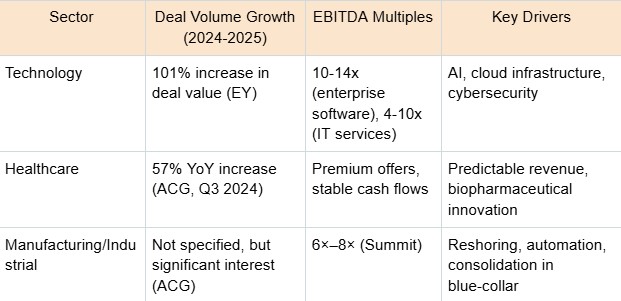By Lou Sokolovskiy
We’ve looked at the most recent data from four prominent studies by Axial, EY, ACG (Middle Market Growth) and Summit Capital Advisors and found that in 2025, a year already marked by economic uncertainty and shifting investor sentiment, three industries—technology, healthcare and manufacturing—are leading the way in mergers and acquisitions across the lower middle market. These sectors are not only attracting interest but demonstrating remarkable resilience, even as inflation concerns and geopolitical risk continue to cloud the broader outlook.
But what exactly makes these sectors so resilient?

Note: The data in this table is derived from findings produced by EY and ACG
Technology: Powered by AI, Backed by Recurring Revenue
Technology has long been a magnet for investment, and 2025 is no exception. Deal value in the sector has more than doubled year-over-year, reaching $65 billion by April, according to EY. Much of this momentum is being driven by artificial intelligence, with 64 percent of executives saying they plan to pursue AI acquisitions this year.
Enterprise software deals are particularly prized, commanding EBITDA multiples in the range of 10 to 14 times earnings, thanks in large part to their recurring revenue models and scalability. IT services typically trade between 4x and 10x, while hardware lags behind at a more modest 2x to 6x. Geography also plays a role: coastal markets tend to see higher valuations than those in the interior.
Healthcare: Stability Meets Opportunity
Healthcare, often viewed as a defensive sector, is undergoing a strategic reappraisal. Lower middle-market deal activity rose 57 percent year-over-year by Q3 2024, according to ACG. Today, healthcare accounts for more than 40 percent of M&A deals in this slice of the market.
Much of that appeal comes from the sector’s reliable cash flow and aging population trends, which continue to support demand. Investors are paying premiums for outpatient care providers, diagnostic labs and biotech companies. In some states, deregulation has further boosted deal flow, making healthcare not just stable, but increasingly growth-oriented.
Manufacturing: A Reshoring Revival
After years of offshoring and contraction, American manufacturing is mounting a quiet comeback. The shift is driven by a confluence of factors: companies looking to strengthen their supply chains, reduce exposure to international volatility, and take advantage of advances in automation. While ACG did not report exact growth figures, Summit Capital Advisors points to strong interest and solid valuations, with EBITDA multiples ranging from 6x to 8x. Investors are eyeing fragmented subsectors—such as HVAC and industrial technology—as prime candidates for consolidation. Independent sponsors, who have recently started focusing more on roll-ups, may find more opportunities in this sector.
Other Sectors and a Note of Caution
Outside the big three, activity is more muted. Fintech and renewable energy have drawn some attention, though with less consistent data to support widespread enthusiasm. Media, chemicals and utilities continue to show limited movement within the lower middle-market range. And while valuations are climbing in high-interest sectors, so too are financing costs. In a tighter credit environment, investors are urged to tread carefully.
A Market of Focused Momentum
The story of M&A in 2025 is not one of across-the-board exuberance, but of concentrated strength. Technology continues to capture investor imagination. Healthcare, once a slow and steady performer, is showing new vitality. And manufacturing is benefitting from a strategic rebalancing of global supply chains.
For investors navigating this part of the market—typically defined as businesses valued between $10 million and $250 million—the key lies in understanding nuance: which sub-sectors are scalable, which regions command premiums, and which trends are likely to outlast the moment.
In a year where risk and reward are both on the rise, it is the well-informed, not the merely aggressive, who are best positioned to seize opportunity.
We sift through the data so you don’t have to.
Our team brings you exclusive, insight-driven coverage of lower middle-market trends—grounded in real numbers, not noise.
Subscribe to our LinkedIn newsletter for in-depth analysis, sector spotlights, and expert perspectives—delivered straight to your feed.
Tell us what you think on LinkedIn or Instagram (@opusconnect). Explore our events and join the community.
Aug. 2025
Note: This analysis was developed in June 2025, using data current through Q2.


